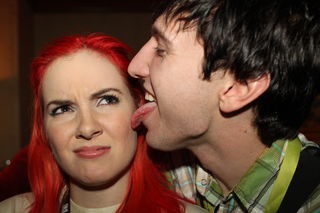Sex
Sex Is Disgusting. Here's Why We Keep Doing It Anyway.
The research on how arousal overpowers disgust.
Posted April 13, 2015 Reviewed by Ekua Hagan

Sex is inherently pretty disgusting: bodily fluids everywhere, strange smells and even stranger noises—and yet by and large we all more or less manage to enjoy it.
This trade-off between wanting to reproduce and wanting to avoid bodily secretions presents an interesting challenge for evolution and has resulted in a complex relationship between being turned on and grossed out.
To understand the relationship between sex and disgust, we first need to know what disgust is and what it does. Disgust has long been considered a universal emotion (Darwin, 1872/1965; Plutchik, 1962; Tomkins & McCarter, 1964), and the facial expressions associated with disgust (think screwed-up nose, visibly pulling away, narrowed eyes to avoid the offensive stimulus) are recognized globally (Ekman & Friesen, 1975).
Based on the consistency in facial expressions of the emotion, early theories of disgust’s utility related to the oral rejection of noxious substances (Ekman & Friesen, 1975; Rozin & Fallon, 1987; Tomkins, 1962). Accordingly, disgust is associated with nausea and vomiting. This all makes intuitive sense, but seems to be missing a large piece of the puzzle. Toxic and foul-tasting substances can elicit disgust responses, but we also commonly experience disgust as a reaction to sexual transgressions and immoral behavior, as well as responding to tactile experiences like coming into contact with dog poo.
Some contemporary approaches to disgust, and many other emotions, employ an evolutionary perspective (Cosmides & Tooby, 2000; Keltner, Haidt, & Shiota, 2006; Ohman & Mineka, 2001; Pinker, 1998). This stems from the fact that our emotions are powerful behavioural motivators that likely evolved as a response to specific and pervasive adaptive problems in our ancestral environment. Based on this approach, disgust is considered to have a number of distinct domains including pathogen and sexual components.
A vast body of academic research acknowledges pathogen disgust as an effective motivator of avoiding potential sources of infection. Pathogen disgust likely evolved as a result of the tremendous pressure that was placed on survival, and indeed reproduction, by disease. Infectious microbes have been a consistent source of danger for hominids, and continue to be today, especially for those in developing nations.
Pathogen disgust thus functions as a behavioural immune system, motivating the organism to avoid contact with potential disease vectors that would necessitate a physiological immune response. Sexual intercourse, while necessary (and fun), also carries a huge risk of exposure to potential pathogens, including some particularly nasty bugs in addition to the usual gamut of infections passed from person to person. The temptation to have sex with risky mates can be ameliorated by disgust, and in this context pathogen and sexual disgust function in a similar manner.
Sexual disgust is unique however, in that it can also dissuade us from bedding down with people who aren’t diseased at all. Say, our close genetic relatives. Inbreeding increases the likelihood of harmful recessive diseases—an obvious handicap to any organism. The thought alone of engaging in intercourse with a sibling or parent is pretty distressing and is likely a result of our evolved capacity for sexual disgust to discourage this very behaviour.
According to Tybur, Lieberman, and Griskevicius (2009), sexual disgust may also have evolved to motivate the avoidance of other costly sexual behaviours like investing time, effort and resources into acquiring poor mates (i.e. those with poor genes, a tendency to stray, or an inability to provide). In turn, the lower an individual’s sexual disgust is, the more likely they are to engage in risky, short-term sexual relationships (Al-Shawaf, Lewis, & Buss, 2014; Tybur, Inbar, Güler, & Molho, 2015).
Given that the cost of a poor mate is higher for females due to the high demands of gestation and raising offspring (which males may well skip out on), females tend to have significantly higher levels of sexual disgust (Tybur, Bryan, Lieberman, Caldwell Hooper, & Merriman, 2011) and are more deliberate in mate choice (see Trivers, 1974).
It seems as though we should be constantly grossed out by the risk of contracting horrible diseases, or even worse, horrible babies from everybody we meet. So why don’t we experience disgust with some people and how are we able to have sex with them?
There are all sorts of things that go into being attracted to someone, but physical attraction may actually be related to health. Things like facial attractiveness, body shape, and symmetry have been found to correlate to various measures of disease resistance (Grammer, Fink, Møller, & Thornhill, 2003; Singh, 1993; Thornhill & Gangestad, 1993, 2006). Once we find someone we’re into in a big way, our body decides that the risk of disease is worth it to try and make a baby (Koukounas & McCabe, 1997; Vonderheide & Mosher, 1988).
To investigate this hypothesis, researchers from the University of Groningen had female participants watch some sexy videos and do some gross stuff like drink out of a cup with a bug in it. Another group of participants watched a video of extreme sports, while a third group struck out and were stuck watching a boring movie about a train (Borg & de Jong, 2012).
The females who had watched erotic videos rated sex-related stimuli as less disgusting and performed more of the disgusting behavioural tasks. Sexual arousal actually resulted in the down-regulation of disgust in preparation for intercourse. This may point to a shared origin of sexual and pathogen disgust which were later refined by unique selective pressures.
This study also confirms that disgust and arousal are antithetical physiological and psychological experiences and when it comes to choosing between the two, we seem to favour sex. After all, survival is meaningless to evolution without reproduction. And who could blame us when sex has evolved to be so darn fun?
Facebook image: Jacob Lund/Shutterstock
References
Al-Shawaf, L., Lewis, D. M. G., & Buss, D. M. (2014). Disgust and mating strategy. Evolution and Human Behavior. doi: 10.1016/j.evolhumbehav.2014.11.003
Borg, C., & de Jong, P. J. (2012). Feelings of disgust and disgust-induced avoidance weaken following induced sexual arousal in women. PloS one, 7(9), e44111. doi: 10.1371/journal.pone.0044111
Cosmides, L., & Tooby, J. (2000). Evolutionary psychology and the emotions. In M. Lewis & S. M. Haviland-Jones (Eds.), Handbook of emotions (2nd ed., pp. 91-115). New York: Guilford Press.
Darwin, C. (1872/1965). The expression of emotions in man and animal (Vol. 94). Chicago: University of Chicago Press.
Ekman, P., & Friesen, W. V. (1975). Unmasking the face: A guide to recognizing emotions from facial clues. Englewood Cliffs, N.J: Prentice-Hall.
Grammer, K., Fink, B., Møller, A. P., & Thornhill, R. (2003). Darwinian aesthetics: sexual selection and the biology of beauty. Biological Reviews, 78(3), 385-407. doi: 10.1017/S1464793102006085
Keltner, D., Haidt, J., & Shiota, L. (2006). Social functionalism and the evolution of emotions. In M. Schaller, D. Kenrick & J. Simpson (Eds.), Evolution and social psychology (pp. 115-142). New York: Psychology Press.
Koukounas, E., & McCabe, M. (1997). Sexual and emotional variables influencing sexual response to erotica. Behaviour research and therapy, 35(3), 221-230. doi: 10.1016/S0005-7967(96)00097-6
Ohman, A., & Mineka, S. (2001). Fears, phobias, and preparedness: Toward an evolved module of fear and fear learning. Psychological review, 108(3), 483. doi: 10.1037/0033-295X.108.3.483
Pinker, S. (1998). How the mind works. London: Penguin.
Plutchik, R. (1962). The emotions: facts, theories and a new model. New York: Random House.
Rozin, P., & Fallon, A. E. (1987). A perspective on disgust. Psychological review, 94(1), 23-41. doi: 10.1037/0033-295X.94.1.23
Singh, D. (1993). Adaptive significance of female physical attractiveness: Role of waist-to-hip ratio. Journal of Personality and Social Psychology, 65(2), 293-307. doi: 10.1037/0022-3514.65.2.293
Thornhill, R., & Gangestad, S. W. (1993). Human facial beauty : Averageness, symmetry, and parasite resistance. Human nature (Hawthorne, N.Y.), 4(3), 237-269. doi: 10.1007/BF02692201
Thornhill, R., & Gangestad, S. W. (2006). Facial sexual dimorphism, developmental stability, and susceptibility to disease in men and women. Evolution and Human Behavior, 27(2), 131-144. doi: 10.1016/j.evolhumbehav.2005.06.001
Tomkins, S. S. (1962). Affect, imagery, consciousness. New York: Springer.
Tomkins, S. S., & McCarter, R. (1964). What and where are the primary affects? Some evidence for a theory. Perceptual and Motor Skill, 18, 119-158.
Trivers, R. L. (1974). Parent-offspring conflict. Integrative and Comparative Biology, 14(1), 249-264.
Tybur, J. M., Bryan, A. D., Lieberman, D., Caldwell Hooper, A. E., & Merriman, L. A. (2011). Sex differences and sex similarities in disgust sensitivity. Personality and Individual Differences, 51(3), 343-348. doi: 10.1016/j.paid.2011.04.003
Tybur, J. M., Inbar, Y., Güler, E., & Molho, C. (2015). Is the relationship between pathogen avoidance and ideological conservatism explained by sexual strategies? Evolution and Human Behavior. doi: 10.1016/j.evolhumbehav.2015.01.006
Tybur, J. M., Lieberman, D., & Griskevicius, V. (2009). Microbes, mating, and morality: individual differences in three functional domains of disgust. Journal of Personality and Social Psychology, 97(1), 103-122. doi: 10.1037/a0015474
Vonderheide, S. G., & Mosher, D. L. (1988). Should I put in my diaphragm?: Sex-guilt and turn-offs. Journal of Psychology & Human Sexuality, 1(1), 97-111. doi: 10.1300/J056v01n01_08




